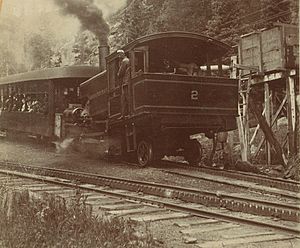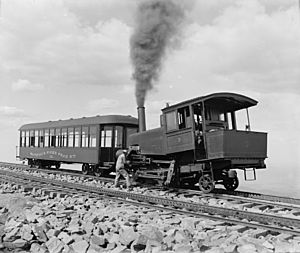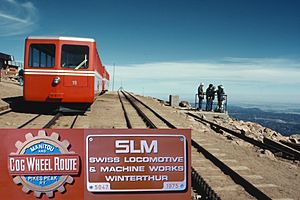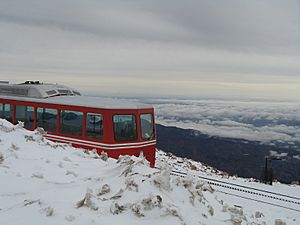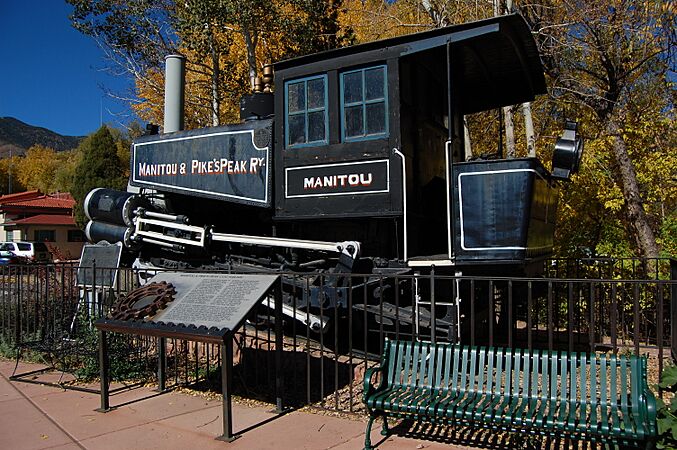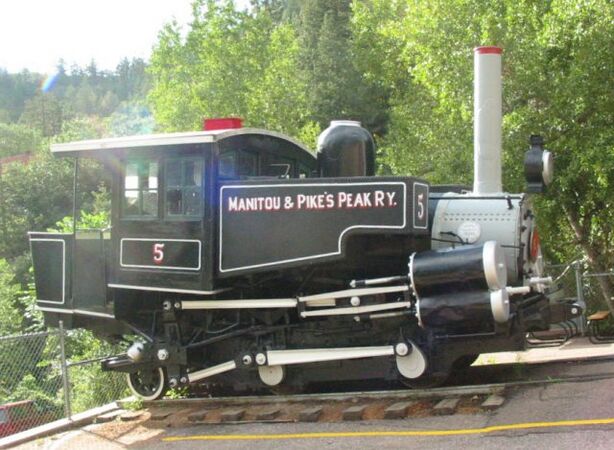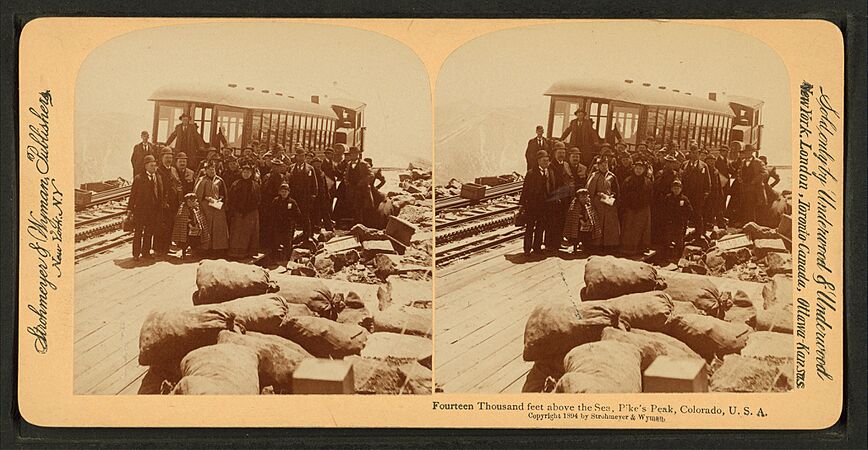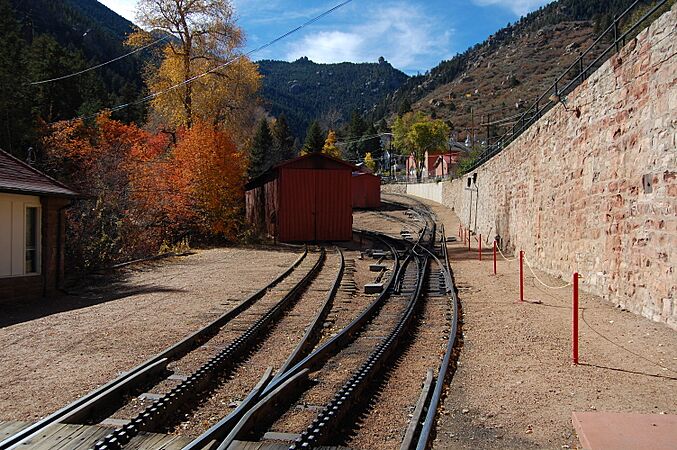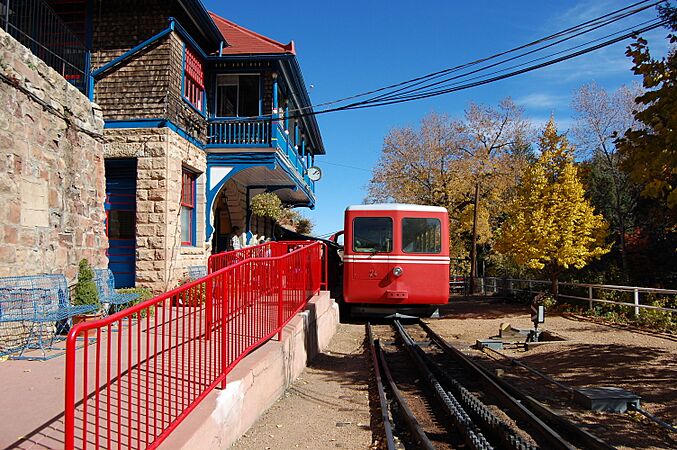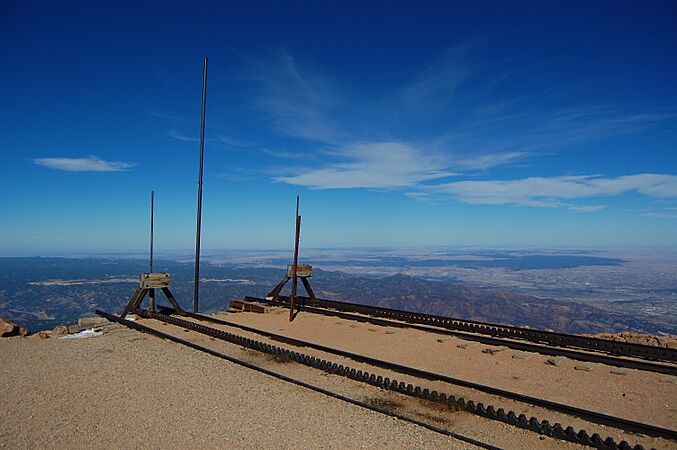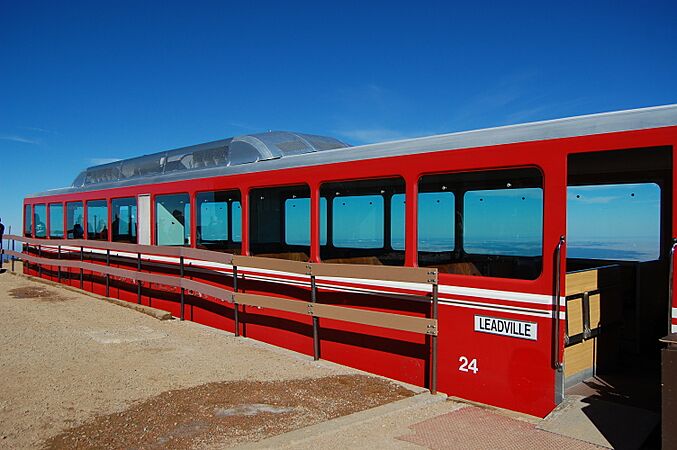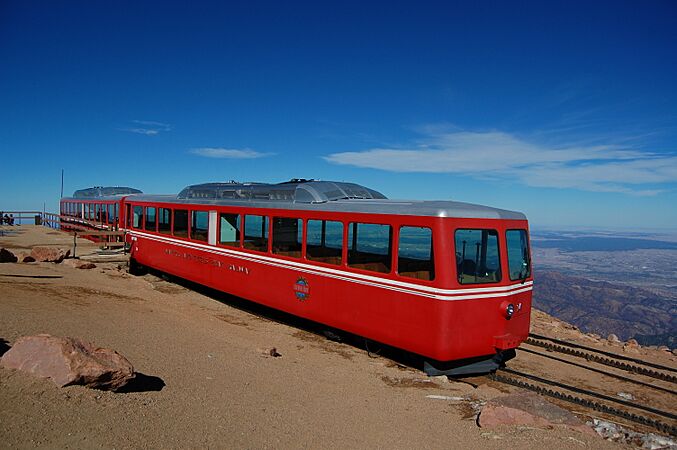Manitou and Pike's Peak Railway facts for kids
| Overview | |
|---|---|
| Headquarters | Manitou Springs, Colorado |
| Reporting mark | MPP |
| Locale | El Paso County, Colorado, U.S. |
| Dates of operation | 1889–2017 |
| Technical | |
| Track gauge | 4 ft 8 1⁄2 in (1,435 mm) standard gauge |
| Electrification | none |
| Length | 8.9 mi (14.3 km) |
| The Broadmoor Pike's Peak Railway | |
|---|---|
| Technical | |
| Line length | 8.9 mi (14.3 km) |
| Rack system | Abt rack system |
| Track gauge | 4 ft 8 1⁄2 in (1,435 mm) standard gauge |
| Electrification | none |
The Broadmoor Pikes Peak Cog Railway is a special kind of train that climbs Pikes Peak in Colorado, United States. It's called a "cog railway" because it uses a toothed wheel (a cog) that locks into a special track (a rack) to help it climb very steep hills. The railway starts in Manitou Springs, Colorado, which is close to Colorado Springs.
This railway is the highest one in North America. It was built for tourists who wanted to see the amazing views from the top of Pikes Peak. The railway closed for a while in 2017 for big upgrades. It is expected to reopen in 2021 with brand new trains and tracks. The old "Abt rack system" will be replaced with a newer "Strub rack system" for better climbing.
Contents
History of the Pikes Peak Cog Railway
The idea for the Pikes Peak Cog Railway came from Zalmon G. Simmons. He was famous for inventing the Simmons Beautyrest Mattress. The railway company officially started in 1889.
The first trains began running in 1890, but only went halfway up the mountain. On June 30, 1891, the very first train finally reached the summit of Pikes Peak!
From Steam to Diesel Trains
At first, the railway used powerful steam locomotives. These trains had special boilers that were tilted to stay level on the steep mountain slopes. Running steam trains on such a steep track was very hard work and cost a lot of money.
So, the railway looked for newer, more efficient trains. In 1938, they built a gasoline-powered train car, called #7. This car was much cheaper to run, especially during quieter times of the year. It was a big success! Soon, the railway bought more trains that used internal combustion engines, like diesel engines.
Starting in 1939, the railway added five sleek diesel locomotives made by General Electric. These new trains slowly took over from the steam engines. Some steam trains were still used until the 1960s as backup or for clearing snow. Today, some of the old steam locomotives are on display. The railway even has one working steam locomotive (#4) and an old passenger car for special events.
New Trains from Switzerland
In 1964, the railway needed more trains, but General Electric wasn't making them anymore. So, they looked to Switzerland, a country famous for its many cog railways.
The Swiss Locomotive and Machine Works (SLM) in Winterthur, Switzerland, built two bright red train cars for Pikes Peak. These "railcars" were special because they had both the engine and passenger seats in one unit. This meant they didn't need a separate pushing locomotive.
More Swiss trains were added in 1968 to carry even more visitors. By 2017, all four of these original Swiss trains were still running!
As tourism grew in the 1970s, the railway needed even bigger trains. In 1976, they got two larger, two-car trains from SLM. These were called Train 18 and Train 19. Around the same time, the railway built "passing sidings" along the track. These are special sections where trains can pull over and let another train pass. Before this, trains could only pass at one spot, limiting how many trips they could make each day. With the new trains and sidings, the railway could run many more trips up the mountain each day!
Today, the railway mostly uses its modern Swiss-built railcars to carry passengers.
The Manitou Incline Trail
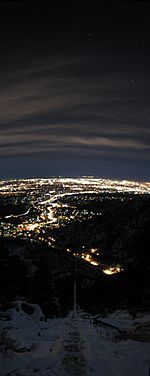
Next to the Cog Railway's base station was another railway called the Mount Manitou Scenic Incline Railway. Most people just called it the Manitou Incline. This was a funicular, which is a type of cable car that pulls cars up a steep slope.
The Manitou Incline was built in 1907 to help build water lines and a power plant. After construction, the Cog Railway company took it over as a tourist attraction. It was very steep, climbing over 2,011 feet (613 m) in about 1 mile (1.6 km)!
The Incline closed in 1990 after a rockslide. For many years, people still used the old track for exercise, even though it was technically closed. But on February 1, 2013, it officially became a legal hiking trail. Now, it's a popular spot for hikers and fitness enthusiasts.
The Railway Today
Before its big renovation, the Pikes Peak Cog Railway had enough trains to run many trips each day, especially from May to September. During quieter months, they would run fewer trains.
The railway used to close in winter, but in 2006, it started offering year-round service. However, winter service depended on how much snow was on the tracks.
In October 2017, the railway closed for major maintenance. In March 2018, it was announced that it would stay closed for a while. But good news came in June 2018: the city approved funding for repairs!
In November 2018, it was confirmed that reconstruction would begin in Spring 2019. The plan was to replace all the tracks, update the train station, and get brand new trains from a company called Stadler Rail. These new trains will bring back the old style of having separate locomotives pulling passenger cars. Some of the older Swiss trains will also be updated and kept in service.
By November 2020, the new Stadler trains were ready! They were shipped to the USA in February 2021. A new snow blower has also been ordered to help keep the tracks clear.
Images for kids
-
Preserved Baldwin Engine No. 1 at the Colorado Railroad Museum.
-
Baldwin Engine No. 4 on display in Williams, Arizona.


